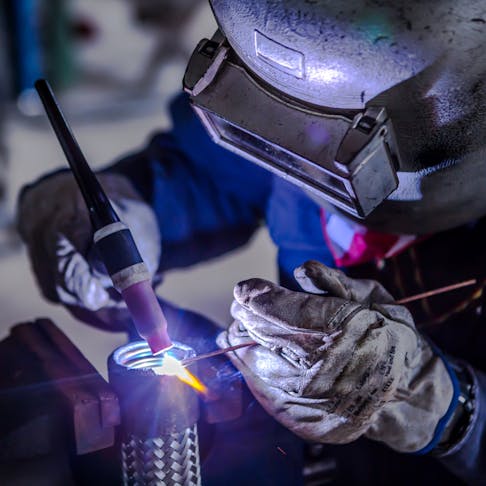Welding WPS for Beginners: Beginning with Welding Procedure Specs
Welding WPS for Beginners: Beginning with Welding Procedure Specs
Blog Article
Understanding Welding WPS Specifications: Finest Practices and Techniques for High Quality Welds
In the realm of welding, grasping Welding Treatment Requirements (WPS) criteria is a critical component that directly influences the top quality and honesty of welds. As we browse through the details of welding WPS standards, discovering crucial insights and techniques for achieving top-tier welds will certainly be paramount for welders looking for to stand out in their craft and create welds that stand the examination of time.
Understanding Welding WPS Requirements

Assessors rely on WPS documentation to validate that welding treatments are being followed properly and that the resulting welds are of high top quality. Engineers make use of WPS criteria to make welding treatments that guarantee the longevity and integrity of bonded frameworks.


Vital Tools for High Quality Welds
Understanding welding WPS requirements is necessary for welders to successfully utilize the vital tools needed for generating high quality welds. One of the most crucial tools for quality welds is a welding equipment. The type of welding machine required depends upon the welding procedure being utilized, such as MIG, TIG, or stick welding. Welding helmets are also essential to safeguard the welder's eyes and face from triggers, warmth, and UV radiation. Additionally, welding handwear covers made of durable and heat-resistant products secure the hands from burns and injuries. Clamps and magnets assist hold the workpieces together firmly throughout the welding process, ensuring exact and specific welds. Cord brushes and chipping hammers are essential for cleansing the weld joint prior to and after welding to get rid of any type of impurities that might affect the high quality of the weld. Finally, a gauging tape and angle mill serve devices for making sure proper positioning and preparing the workpieces for welding.
Trick Strategies for Welding Success
To accomplish welding success, one have to master the essential strategies important for generating top notch welds. One essential strategy is maintaining the right arc length. Maintaining the electrode at the ideal range from the workpiece is crucial for creating strong, uniform welds. Furthermore, regulating the travel rate is critical. Relocating too promptly can cause inadequate infiltration, while moving too gradually can bring about extreme warm input and prospective issues. Appropriate control of the electrode angle is another important strategy. The angle at which the electrode is held can affect the bead form and infiltration of the weld. article Additionally, ensuring consistent weapon angle and direction of travel is vital for harmony in the weld bead. Lastly, keeping a steady welding and a steady hand setting throughout the procedure is essential to accomplishing precision and uniformity in the welds. By grasping these key methods, welders can raise the high quality of their work and achieve welding success.
Ensuring Conformity With WPS Requirements

Additionally, welders ought to undergo training to familiarize themselves with the WPS criteria pertinent to their job. Regular audits and inspections need to be conducted to verify that welding activities line up with the suggested WPS standards. Furthermore, maintaining in-depth records of welding specifications, equipment calibration, and examination results is crucial for demonstrating conformity with WPS criteria - welding WPS. By vigilantly adhering to WPS criteria, welders can ensure that their job meets the required top quality levels and adds to the overall success of the welding project.
Troubleshooting Common Welding Issues
When encountered with usual welding concerns, recognizing the origin is essential for efficient troubleshooting. One common browse this site problem is the presence of porosity in welds, usually triggered by contaminants such as corrosion, oil, or moisture. To resolve this, making certain appropriate cleaning of the base steel prior to welding and making use of the proper shielding gas can considerably decrease porosity. Another problem frequently encountered is lack of combination, where the weld falls short to effectively bond with the base product. This can stem from poor warm input or improper welding method. Changing specifications such as voltage, wire feed rate, or take a trip rate can help boost fusion. In addition, distortion, breaking, and spatter prevail welding difficulties that can be alleviated via correct joint prep work, regular warm control, and picking the suitable welding consumables. By thoroughly recognizing these usual welding problems and their root triggers, welders can effectively troubleshoot troubles and accomplish premium welds.
Conclusion
In verdict, grasping welding WPS requirements requires a comprehensive understanding of the guidelines, using essential devices, and implementing crucial methods for successful welds. Making certain compliance with WPS standards is essential for producing quality welds and official statement preventing usual welding concerns. By following best practices and strategies, welders can accomplish trusted and regular outcomes in their welding jobs.
In the world of welding, grasping Welding Procedure Specification (WPS) requirements is a critical element that straight affects the high quality and honesty of welds.When diving right into the realm of welding practices, a vital facet to comprehend is the importance and ins and outs of Welding Procedure Specification (WPS) criteria. WPS standards give an in-depth standard for welding procedures, guaranteeing uniformity, top quality, and safety and security in the welding process. The kind of welding equipment required depends on the welding procedure being made use of, such as MIG, TIG, or stick welding.Attaining welding success through the mastery of key methods requires a detailed understanding and adherence to Welding Procedure Spec (WPS) criteria.
Report this page